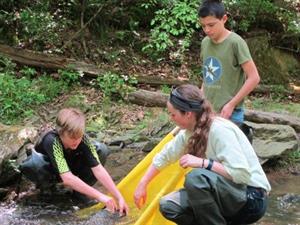Samantha Briggs, IWLA Save Our Streams Coordinator
I am once again packing up my car for a Save Our Streams workshop. I have spent most weekends over the past several months training Ikes and other volunteers across the country – to the point that I track my schedule based on workshops (not by weeks or months). Since March 10, I have trained volunteers in Maryland, Virginia, Ohio, Illinois, and Minnesota, with more workshops (and enthusiastic volunteers) to come in Wisconsin and South Dakota before the monitoring season ends. Other League staff have led trainings in Maryland, Virginia, and Iowa, with Nebraska, Pennsylvania, West Virginia, North Carolina, and Wisconsin still on their schedules.
Why the surge in stream monitor trainings? It’s all part of meeting the League’s Clean Water Challenge.
 The goal of the Clean Water Challenge is to monitor 100,000 new stream sites by 2022. Water quality monitoring is not an innate skill – especially when it comes to the particulars of bug identification or reading chemical test levels. That’s where League staff can help. Volunteers we train will be able to monitor their local streams for chemical, physical, and biological parameters of water quality, which will tell them if their stream is in excellent, good, fair, or poor health. Because we have a big goal of monitoring 100,000 more stream sites, we also have a big goal of training 250 new stream monitors – and that’s just this spring!
The goal of the Clean Water Challenge is to monitor 100,000 new stream sites by 2022. Water quality monitoring is not an innate skill – especially when it comes to the particulars of bug identification or reading chemical test levels. That’s where League staff can help. Volunteers we train will be able to monitor their local streams for chemical, physical, and biological parameters of water quality, which will tell them if their stream is in excellent, good, fair, or poor health. Because we have a big goal of monitoring 100,000 more stream sites, we also have a big goal of training 250 new stream monitors – and that’s just this spring!
It will take a lot more volunteers to help us reach that goal. But our work doesn’t end with a water quality rating. We are also training volunteers to be the voice for their stream within the community, working at the local and state levels to improve water quality.
Spring is my favorite season to be outside. Animals, insects, and plants that are dormant throughout the winter are finally coming out with a flourish! This is one of the best times for biological (macroinvertebrate) monitoring because the bugs are finally active after a cold winter, making them easier to see and identify. Spring is also a great time to try something new – like stream monitoring!
Look for a workshop near you or request one on our Water Workshops web page. For more ways to get involved in the Clean Water Challenge, visit our Challenge web page.